Access Control System
Access control systems are based on the premise that issuing keys to all employees who need them is generally not cost-effective. Another premise of an access control system is that it would be cost-prohibitive to rekey the facility should a key be lost. Finally, an access control system can limit employee access; allowing them entry only to areas in which they are authorized, or granting entry during certain times of the day. An access control system uses a means of verification, known as a credential, to allow a person to enter an area. The credential can be something that is known, generally a personal identification number; something that is carried, such as a card or token; or something that the authorized person has, such as a fingerprint or iris (the colored part of the eye). The credential is entered, swiped, presented, or scanned, and, after some level of verification, access is granted or denied.


